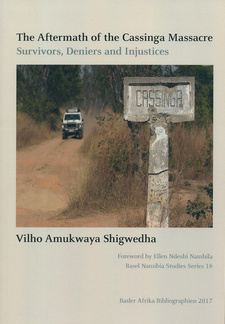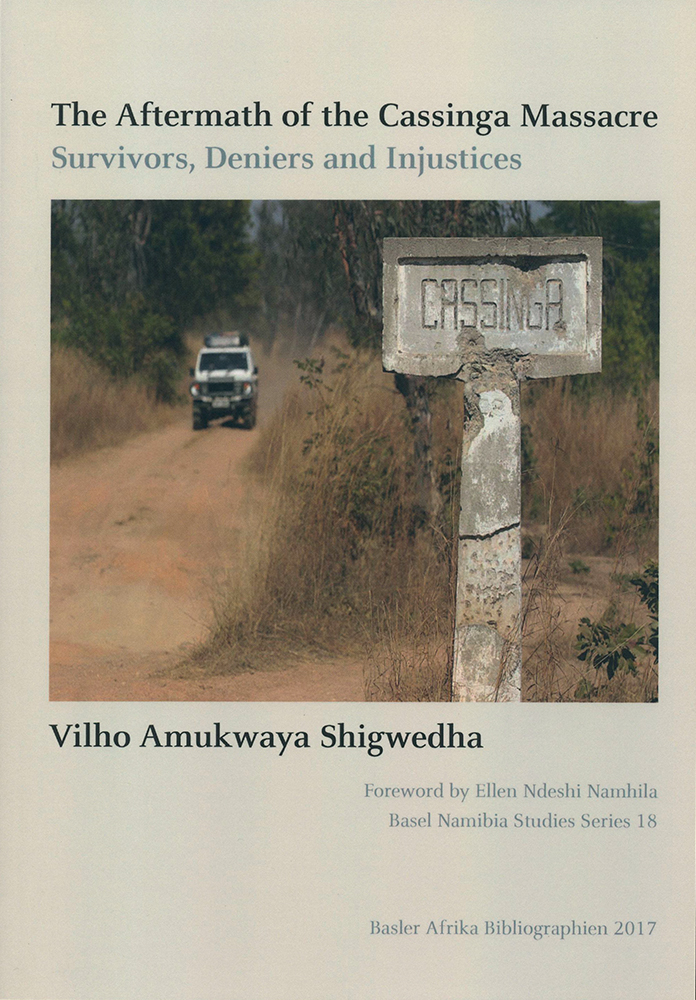The Aftermath of the Cassinga Massacre: Survivors, Deniers and Injustices, by Vilho Amukwaya Shigwedha

The Aftermath of the Cassinga Massacre: Survivors, Deniers and Injustices, by Vilho Amukwaya Shigwedha. Basler Afrika Bibliographien. Basel, Switzerland 2017. ISBN 9783905758801 / ISBN 978-3-905758-80-1
By writing his book, The Aftermath of the Cassinga Massacre: Survivors, Deniers and Injustices, Vilho Amukwaya Shigwedha intends to and succeeds in opening a discursive space in which the dominant national versions of the Cassinga massacre that circulate in Namibia, and the too long afterlife of the SADF version of the massacre, may be challenged and interrupted so as to allow for more open-ended narratives.
[...] In an exploratory manner, the book navigates the reader through the conundrum of survivors' ongoing painful testimonies of the Cassinga massacre in contrast with those perpetrators who remain obstinate and unremorseful, celebrating the killing of innocent women and children in Cassinga as a great military achievement. This inflames the victims' anger and bitterness. It also raises a concern that the ongoing suffering of the Cassinga victims is as a result of post-colonial Namibia's failure to encourage the victims and perpetrators to negotiate the past openly and hold those responsible for the violence accountable. In attempts to disentangle these challenges the author grapples with the persisting physical and emotional trauma of the survivors with the absence of closure for friends and families, but also with the unresolved scars the massacre left in the minds of the perpetrators. Because - and this is noteworthy - not all the South African soldiers involved in the attack share the unrepentant attitude of General Breytenbach and his ilk, and they have their own nightmares to deal with. Shigwedha juxtaposes and contrasts different sources such as testimonies from survivors, oral and written narratives of perpetrators and photographs from different archives. With an incisive analysis of the content, use, and interpretation of selected "iconic" photographs, he demonstrates how the widely disseminated image of the mass grave obscures the tragedy behind it, and how the South African photos intended to hide the truth about the massacre does, on the contrary, evoke the vivid memory and wrath of a survivor. By doing so he intends to and succeeds in opening a discursive space in which the dominant national versions of the Cassinga massacre that circulate in Namibia, and the too long afterlife of the SADF version of the massacre, may be challenged and interrupted so as to allow for more open-ended narratives. Such narratives, as the author convincingly demonstrates, elaborate and critique colonial-apartheid violence yet evade the co-option of justifying or redeeming a postcolonial national or nationalist framing. As the central argu ment accumulates from one chapter to the next, a vast and deeply contested social, sensory, embodied and discursive landscape of ruin and devastation painstakingly emerge. The 'accumulative' structure of the book is persuasive and allows the argument to gather force. By the time the perpetrators' narratives are engaged in Chapter 5, a meticulously close reading of primary sources, including the few from the South African military archives, which the author was finally permitted to access, exposes the disinformation campaign that was already designed in the planning stages of "Operation Reindeer," the military codename for the attack on Cassinga. The author explores in detail how the denials, contradictions, lies and disingenuous claims that circulate in public versions of the massacre associated with the perpetrators' public narratives operate. The book is based on extensive oral testimony. It is disconcerting to read the survivors' attempts to disclose, via testimony, their individual experiences of continued pain and suffering and their cry for justice to help alleviate their suffering and their tangible and explicit everyday misery. As they attempt to make their pain and suffering known, they experience insurmountable difficulties with the testimony's incapacity to expose their predicaments fully. They communicate traumatic flashbacks that are more ambiguous than what the victims intend unpacking for the public understanding. [...] Ellen Ndeshi Namhila, University of Namibia: Pro Vice Chancellor
This is an excerpt from: The Aftermath of the Cassinga Massacre: Survivors, Deniers and Injustices, by Vilho Amukwaya Shigwedha.
Title: The Aftermath of the Cassinga Massacre
Subtitle: Survivors, Deniers and Injustices
Author: Vilho Amukwaya Shigwedha
Publisher: Basler Afrika Bibliographien
Basel, Switzerland 2017
ISBN 9783905758801 / ISBN 978-3-905758-80-1
Softcover, 17 x 24 cm, 186 Seiten, several b/w photos
Shigwedha, Vilho Amukwaya im Namibiana-Buchangebot
The Aftermath of the Cassinga Massacre
The Aftermath of the Cassinga Massacre: Survivors, Deniers and Injustices.

